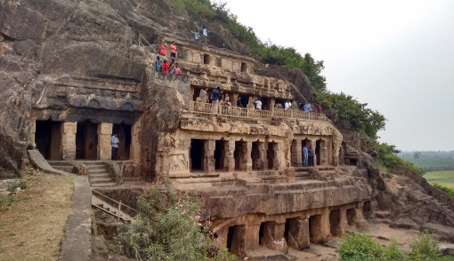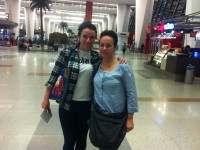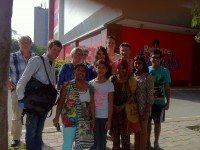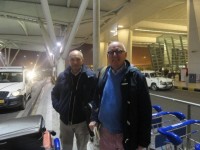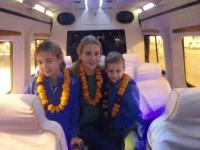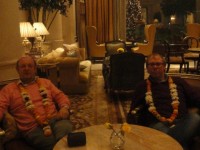
Vijayawada
Vijayawada earlier known as Bezawada, is the third largest city in Andhra Pradesh, India, located on the banks of the Krishna River and bounded by the Indrakiladri Hills on the West and the Budameru River on the North. Vijayawada literally translates to “The Place of Victory”. Its prominence as a major trading and business center has earned it the title of, “The Business Capital of Andhra Pradesh”. Situated along the Madras-Howrah and Madras-Delhi Railway route, this is the largest railway junction of the South Central Railway region. The city is in Krishna District, about 282 kilometres from the state capital Hyderabad. Lying in the rich coastal delta of the state, the cuisine of Vijaywada is spicy and deliciously varied.
Vijayawada is also a centre of Andhra culture, and is a religious center. The Chalukyas of Kalyan once conquered this place, and the famous Chinese Xuanzang (Hsuan-tsang) had visited this place in 639 AD when Buddhism was at its zenith in the region. Kings Choda Gangadeva and Ananga Bhimadeva of the Eastern Ganga Dynasty in the 12th century whose capital was in modern Bhubaneswar and who built the Lingaraja temple had re-annexed considerable part of modern Andhra region and marched up to Godavari but could not cross the wide river bed. He established a town ‘Vijaya Bahuda’ which means ‘return after winning’ which became known as Vijayawada.
During the British Raj the city experienced significant growth. In particular, the completion of the Prakasam Barrage in 1959, and railway bridge on the Krishna River have helped the region expand its agriculture and commercial base. Vijayawada Railway station is one of the busiest railway junctions in India. The regions around the city have fertile soil and are irrigated by the river Krishna.
Vijayawada is bounded by the Indrakiladri Hills on the west and the Budameru River on the north. The Northern, North-Western, and South-Western parts of the city are covered by a low range of hills, while the Central, South-Western and North-Western parts are covered by rich and fertile agriculture lands with three major irrigation canals. The topography of Vijayawada is flat, with a few small to medium sized hills. The Krishna River runs through the city. These hills are part of the Eastern Ghats cut through by the Krishna river. They have very low elevation compared to the average elevation of the ghats. Three canals originating from the north side of the Prakasham barrage reservoir, Eluru, Bandar and Ryves, run through the city. Vijayawada is the only city in the world with two rivers, Krishna, Budameru, and three canals. Buckingham Canal originates from the south side of the reservoir. Due to the presence of the Krishna river the soil around here is very fertile and cultivated intensively.
Connectivity
By Flight
The airport is located 13.5 km from the city
By Rail
Viajaywada Railway station : Viajaywada Junction
By Road
By Road : National Highway 5 is connecting Vijayawada
Prakasham Barrage: Built across the river Krishna connecting Guntur District, Prakasham Barrage has created a panoramic lake. Its three canals that run through the city give Vijayawada a Venetian look.
Kanaka Durga Temple: One of the most popular temples in Andhra Pradesh, it is located on Indrakeeladri hill overlooking the city as well as the River Krishna. It was built after 12th century by Maharaja Poosapati Madhava Varma, the ancestor of Vijayanagaram Poosapati Kings, according to History. He is the builder of Modern Vijayawada kingdom.
Gandhi Hill: The first Gandhi Memorial with seven stupas in the country was constructed on this hill at a height of 500 ft (150 m). The 52 ft (16 m) stupa was unveiled on 6 October 1968 by Dr. Zakir Hussain, the President of India. Gandhi Memorial Library, a Sound and Light Show on Mahatma Gandhi’s life and a planetarium are the other attractions.
Mogalarajapuram Caves: These caves are said to be excavated in 5th century A.D. The caves are reputed to be the first of their kind in South India. The idols of Lord Nataraja, Vinayaka & Arthanareeswara are carved here, but none of the statue are available here.
Victoria Museum: A place for archaeology lovers, Victoria Museum has a carefully preserved collection of ancient sculptures, paintings, idols, weapons, cutlery, and inscriptions.
Hazarat Bal Mosque: A holy relic of the Prophet Mohammed is kept here which is displayed once a year. A large number of non-Muslims too join the celebrations.
Rajiv Gandhi Park : Created by the Vijayawada Municipal Corporation with great care, this park welcomes the tourists at the entrance of the city with its impressive horticultural network. A mini zoo and a musical water fountain are added to it.
Gunadala Matha Shrine: In 1925, Rf. Arlati, the Rector of St. Joseph’s Orphanage at Gunadala, installed a statue of Our Lady and later a church was built and consecrated in 1971, now popularly known as St. Mary’s church. Since then the Feast of Our Lady of Lourdes became an annual event here, attended by hundreds of people. The church is situated on a hillock on the eastern side of the city.
Bhavani Island: Perhaps one of the largest islands on a river, Bhavani Island is in Krishna River close to the city. AP Tourism is converting this 133-acre (54 hectare) island into an attractive tourist spot and a riverfront resort. The island has some cottages to stay in and some good adventure and fun sports. The journey to the island by boat is very pleasant.
Mangalagiri: Mangalagiri is a near by town which is a famous pilgrim centre for its Panakala Lakshmi Narasimha Swami Temple which is one among the tallest temple towers of the India. Mangalagiri is also famous for its traditional textiles.
Namburu: Namburu is a suburban of Vijayawada and Guntur . Though a village, it gives an ornate urban living because of well-established townships. Nambur is famous for spiritual centres namely Kaligardens, Hreenkar theerth (Jain temple) which is one of the master piece for its architecture. Acharya Nagarjuna University is in Nambur.



